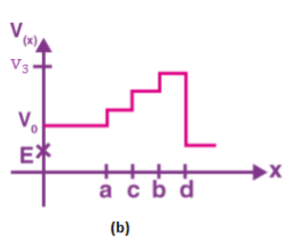

The total energy is given by the relation,
![]() .
.
So,
![]()
There can never be a negative amount of kinetic energy. In the region where K.E. becomes negative, the particle cannot exist.
(a) Potential energy is zero between the points x=0 and x=a. As a result, kinetic energy is a positive quantity. Because x>a, the potential energy is higher than E. As a result, kinetic energy is zero. As a result, the particle will not exist in the x>a region.
The minimum total energy that the particle can have in this case is zero.
(b) The object’s kinetic energy would be negative along the entire x-axis, P.E. >E. As a result, the particle will not be found in this area.
